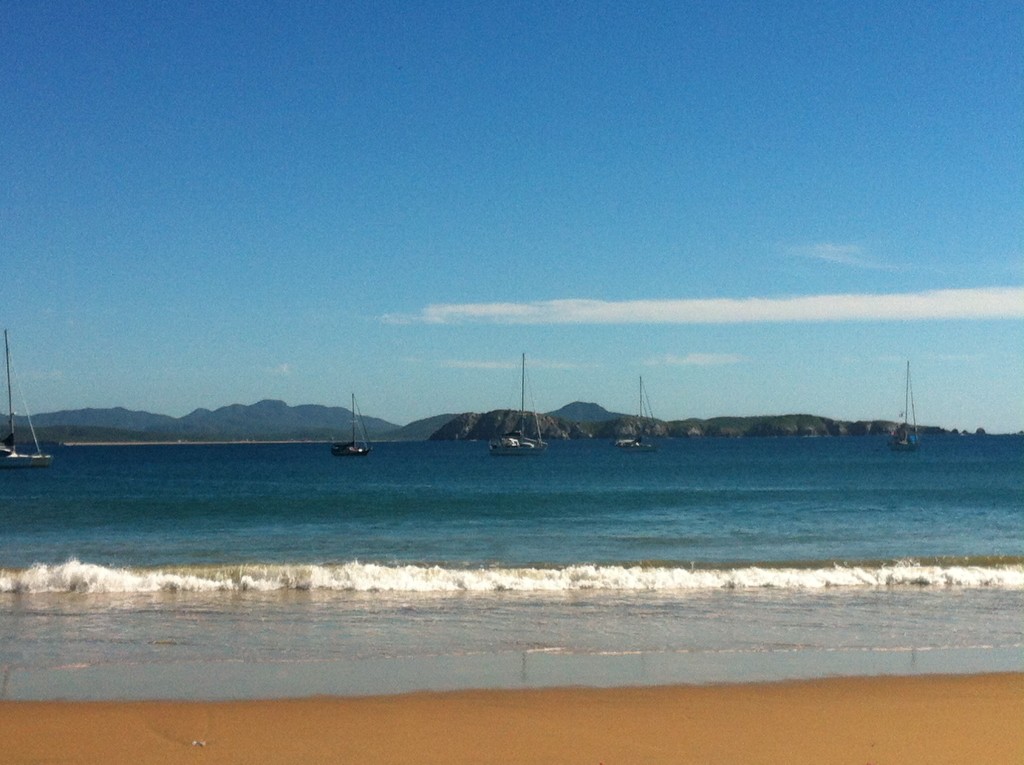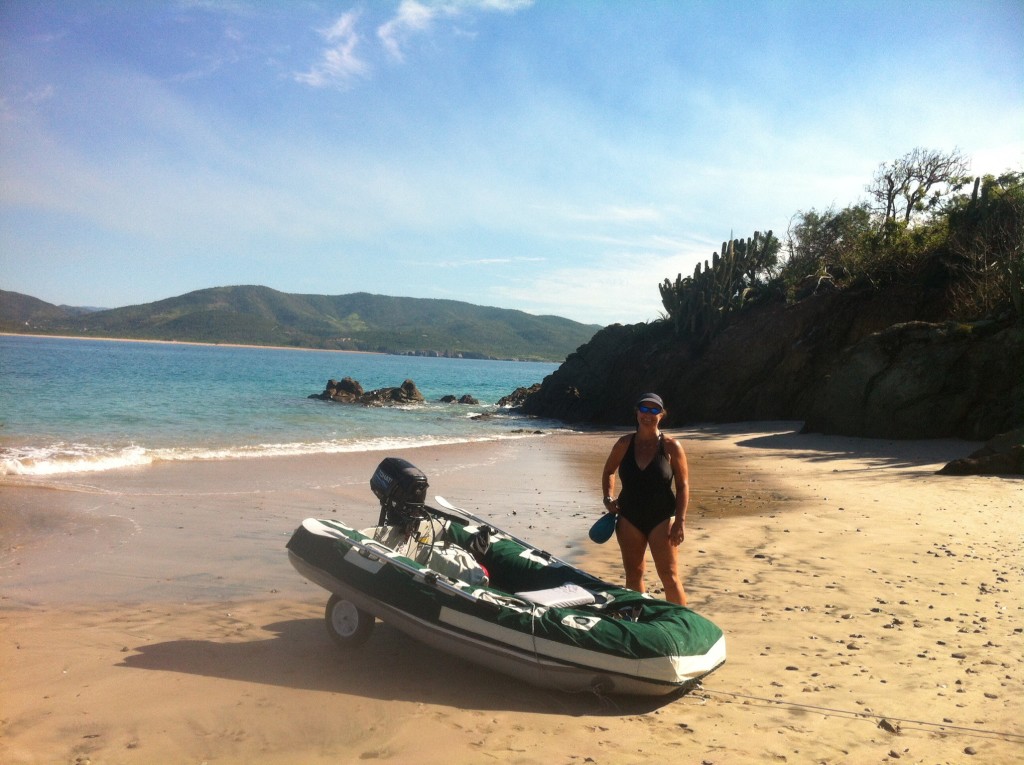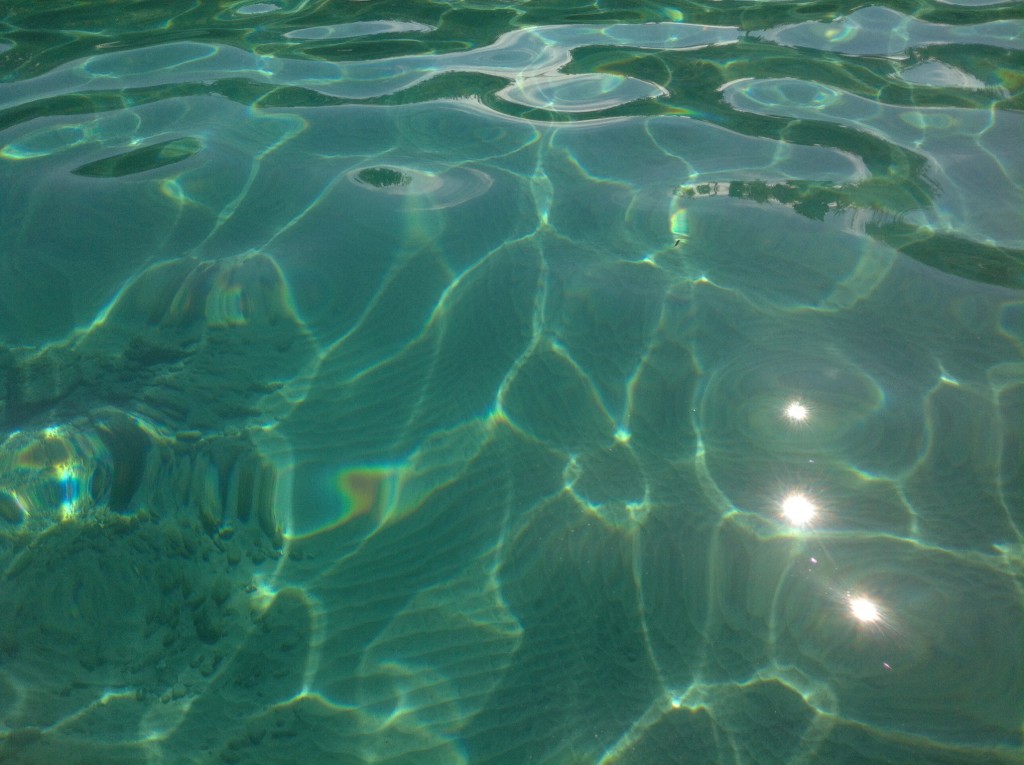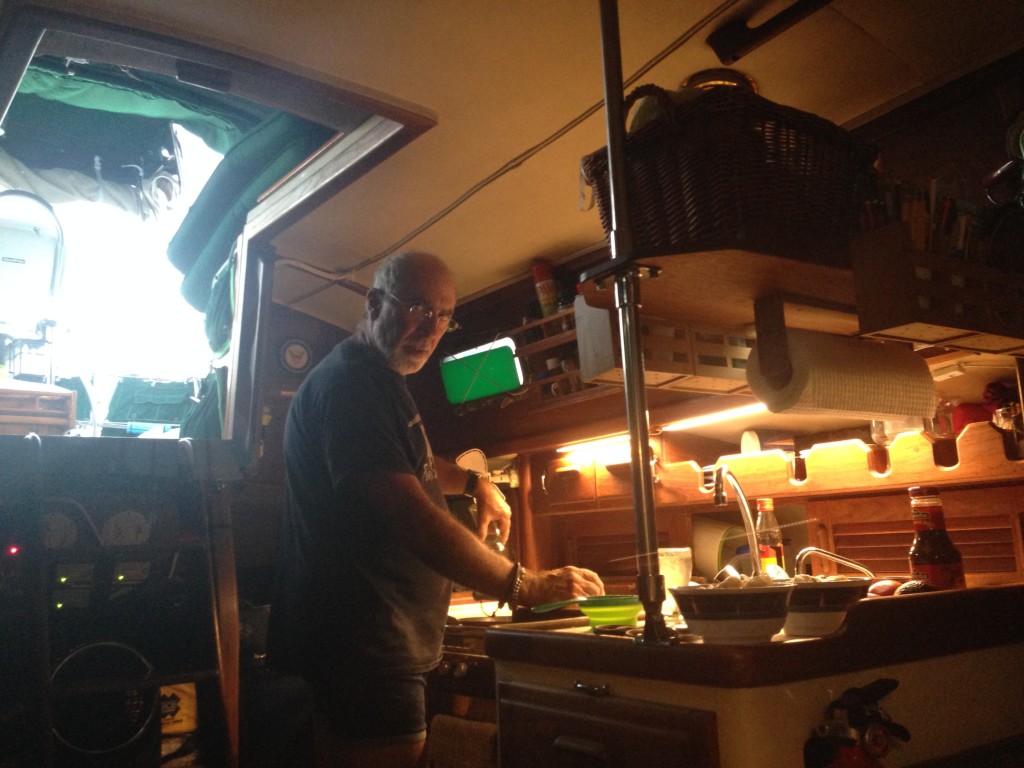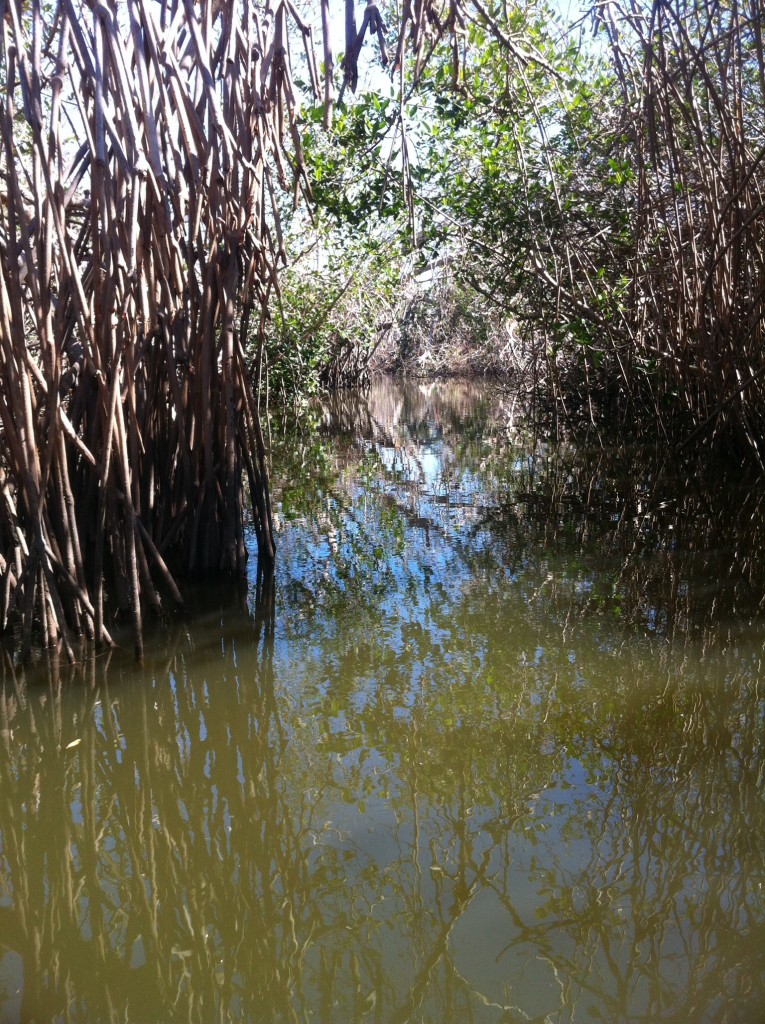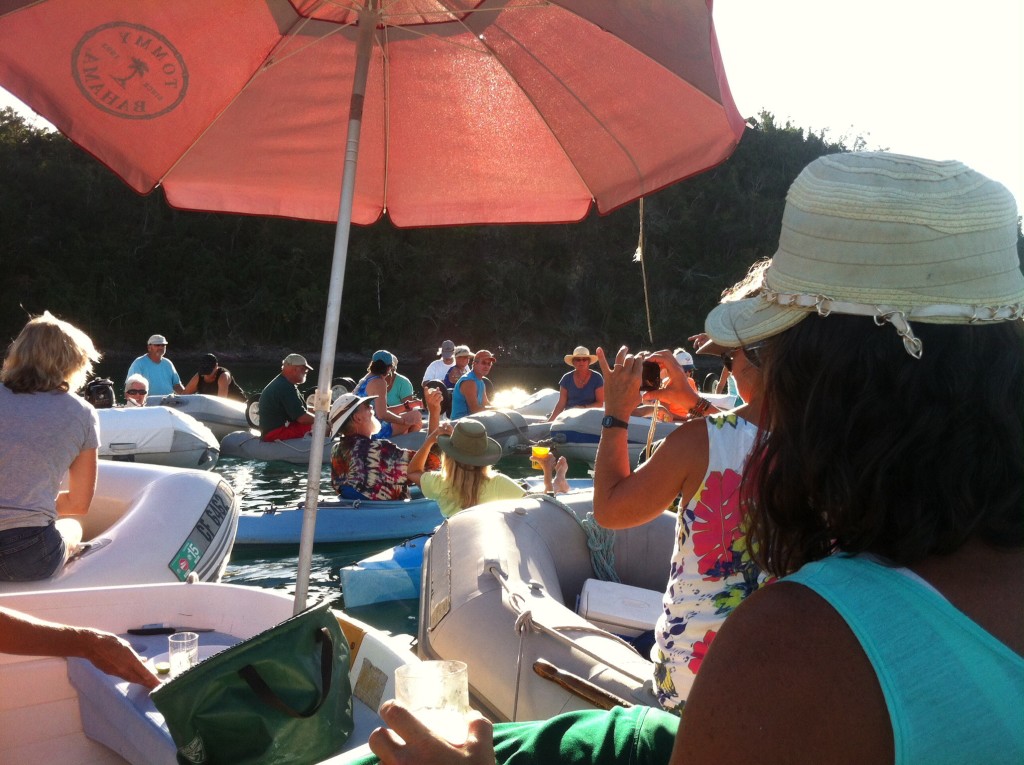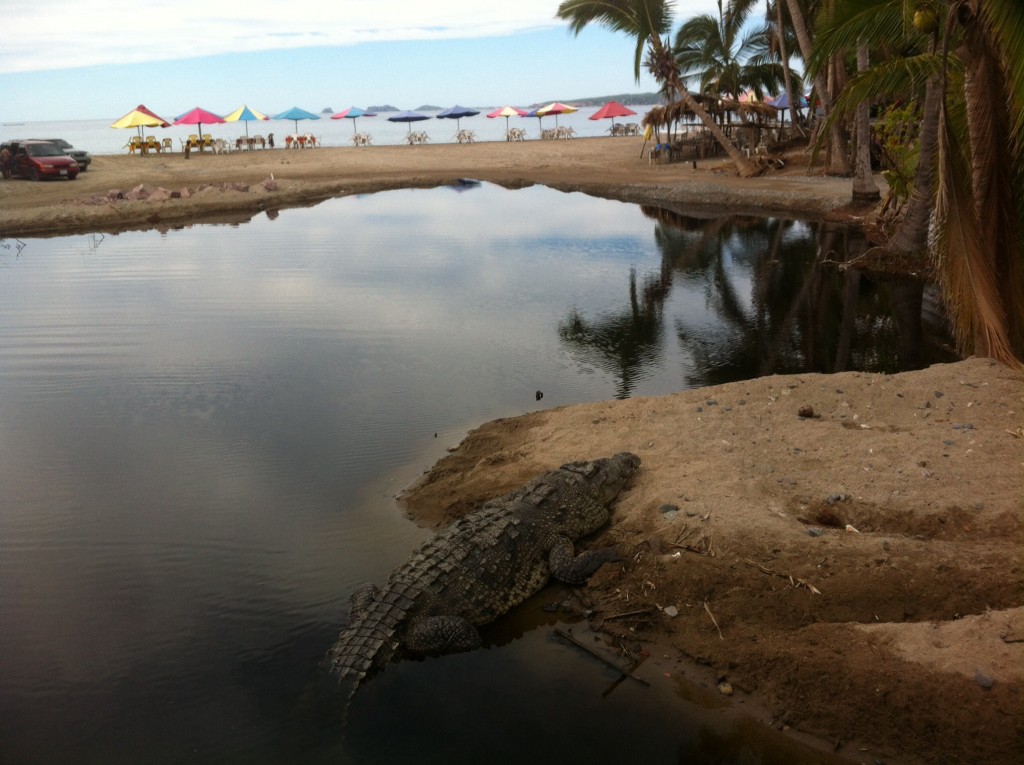After one of my least favorite overnight passages, rounding Cabo Corrientes, Chamela was a welcome sight. Hours before, during the late night before sunrise, we tried to slow our pace to arrive after first light. We are amongst those cruisers who believe that you should avoid entering an unfamiliar anchorage at night. The wind cooperated by dropping down so low that we had to start up the motor, and we maintained Cool Change at a slow pace. So we ended up entering the anchorage well after sunrise, about 9:30 am, approximately 26 hours after we left Banderas Bay.
We were very lucky that the Chamela anchorage was free of any movement whatsoever during our stay. No rocking at night; just a quiet night and a good night’s sleep. There is not much on the shore near the anchorage: just a couple of palapa restaurants on the beach on the outskirts of a small town. But nevertheless it was important to us to be able to get to shore with our dinghy without flipping, and we could, since the swells were quite mild and the corresponding wave breaks were small.
Chamela Bay’s fairly easy surf for dinghy landings made for great practice in refining our dinghy landing and launching skills. It is not always that easy, other cruisers told us, and indeed, we observed a seasoned boater flip his dinghy and ruin his outboard while entering the surf only moments after us. So we were actually quite proud of our technique, which so far has served us well. As any whitewater rafter will tell you, the most important thing to avoid is getting sideways to a wave, so with our whitewater experience, we had a head start in understanding that concept. Getting sideways to a wave is most likely to happen on landing once you have gotten through the bulk of the surf but just haven’t quite gotten the boat out of the water yet. We addressed that problem by first, having the dinghy wheels down before we attempted the landing, so that we could quickly pull the boat onto shore without raising the motor, and second, by Cindy hopping out first and pulling the boat to shore while Rick used the motor as a rudder to keep us straight and turned off the engine. Launching, however, is yet more trechorous. Our strategy so far has been for Cindy to hop in and start rowing out past the break while Rick pushes for as long as he can and then jumps in and starts the motor once we are free of the surf break so he can take his time. So far, so good. Flipping the dinghy is not so bad if the motor is not mounted on the transom, but salt water in a four stroke engine means engine death. And we don’t have a spare!
Chamela Bay is quite large, with several interesting islands. The town of Chamela itself is on the southern end of the bay and not an attractive anchorage because it is exposed to prevailing NW winds and seas. But the NW corner of the bay is well protected so that is where we stayed, along with at least a dozen other boats. we asked a local proprietor of one of the palapa restaurants on the beach to watch our dinghy in exchange for buying some beers from them. The town near the anchorage in Chamela Bay is called Pérula, where we found everything we needed. There was one hotel along the beach within walking distance, and they did our laundry for a reasonable fee. Rick found a fishing supply store that seemed just as happy to find us as we were to find them; Rick bought a spool of fishing line and they gave us a very cool reusable bag with their name printed on it, in Rick’s choice of color. We found ice, tomatoes, cream, onions, zucchini, and papaya, our staples, and we were happy.

Cindy sitting on a panga on the beach in Chamela on our way walking to the town of Pérula for groceries and ice. This anchorage is really fairly remote.
We had heard that the snorkeling in Chamela Bay was great and we didn’t want to miss out. Supposedly, one of the best places to snorkel was around the island of Isla Pajarera, but we kept hearing marine radio reports of other boats returning from there because it was too rolly. Nevertheless, after an earlier dinghy tour of the islands, we decided to anchor at Isla Pajarera on our last night in Chamela Bay, and what a paradise we found. Maybe it was rolly the day before and the day after were we there, but the day and night we spent there were perfect. We rowed our dinghy to the shore and then held hands while snorkeling. We saw beautiful tropical fish colored in blue and yellow, and enjoyed swimming with extra power of our fins to counter currents and swim into caves. It was really fun.
PARAISO
The next day we took off for a little anchorage called Paraiso, delighted with our stay in Chamela Bay. Paraiso means Paradise. It is a small, lovely anchorage with reportedly great snorkeling. The small bay has room for really only one boat, especially considering a commercial mooring that has been placed where the second possible anchorage could have been. And one boat was already in the anchorage, a large ketch, smack in the middle on bow and stern anchors so there really wasn’t room on either side for us but we tried anyway.
A commercial power boat had brought in a large Mexican family for the day, who had set up a BBQ on the beach of the cute little mini-cove within in the larger bay. Their setting reminded us of a Robinson Crusoe beach, with palm trees scattered for shelter behind a small curved white sand beach.
We re-anchored three times; the first time we anchored too close to the commercial mooring, and the second time, Rick swam the stern anchor and found it about to wrap on a tree stump in a clutter of bad anchoring ground. By the third time we got bow and stern anchors deployed, it was too late in the day to consider moving so we hoped for the best. It was actually quite lovely sitting on the bow in the early evening, planning our next day to dinghy around the anchorage and do some snorkeling.
Well our hopes were not satisfied. The night was rolly and miserable. We were both worried about our holding because of the size of the rollers. Paraiso is the the southeast corner of a larger bay cluttered with large land masses that channel and augment the size of the rollers into Paraiso, so NW swells become magnified in the shallower water before they approach boats anchored there. Fortunately, they were approaching us on our bow, but with such force that no sleep was to be had. Just as I would hear the Rick’s heavy breathing, signifying he had finally turned the corner on sleep, a wave would hit us violently and he would wake up again. And I wasn’t much better off. Worse yet, we were only 150 feet off a rock wall that was a lee shore, so we both worried all night long even though we trusted our bow anchor. Even the loss of our stern anchor, a less dependable Fortress, could mean swinging dangerously close to that wall and the rocks that bordered it. A good night’s sleep was therefore unattainable. We both got out of bed grumpy the next morning. And then we found that the stern anchor had dislodged, adding to our anxiety that we survived a brush of our port side with a rock wall by a very small margin. We weighed anchors as soon as we could and got out of there without having had an opportunity to enjoy snorkeling or pretending to be Robinson Crusoe.
TENACATITA
Sailing into Tenacatita anchorage was like sailing into heaven. As we turned the corner behind a green jungled landmass deep into the north side of Tenacatita Bay, we saw a broad expanse of south facing beach with gentle breakers caressing the shoreline. The seas calmed, the water turned to glass, and there were plenty of good anchor spots left amongst the several sailboats already anchored in the large flat bay.
It had been a long day motoring down the 20 or so miles from our previous anchorage because there was no wind, it was hot, and we were both grumpy due to sleep deprevation. So when we saw how protected Tenacatita anchorage was, we both exhaled. A cruiser we knew from last season paddled over on his standup paddleboard to welcome us and invite us to a game of bocce ball on the beach the next day. After chatting with him, getting situated in the anchorage, and having some previously-made Chinese chicken salad for dinner, we sat up on the bow with a bottle of California Old Vine Zin and sang praises to our new home. We starred at the stars, saw a satellite, and admired the sliver of a moon that allowed us to see so much of the night sky. Then we had the best night’s sleep we had had in days.
The next day we listened to the makeshift cruisers radio net, hosted by a new volunteer each day, and we asked a few dumb questions like all newcomers do who have the guts to get on the net. Where do you land on the beach in the nearby town? (At the calmest surf, duh!) And are there any crocodiles in the bay? (Not to our knowledge says the leader of the swim club). Then we headed off in our dinghy to the town 3 miles or so across the bay, only to realize one mile later that we forgot to mount the dinghy wheels onto the dinghy. We had already been warned by several people to have respect for this dinghy surf landing, so doing it without wheels to keep the motor up and move quickly from the surf was out of the question. So we returned to the anchorage for our wheels, and headed back again. Ironically, we forgot to drop the dinghy wheels before we made our beach landing, but we landed without wheels just fine in any case. We surfed a big wave right into the shore – I guess all of those whitewater rafting skills were coming in handy again. We also headed off with enough gasoline to get to the cute little town of La Manzanilla, we hoped, but not enough gas to get back, and no one could confirm that they did in fact sell gasoline in La Manzanilla.
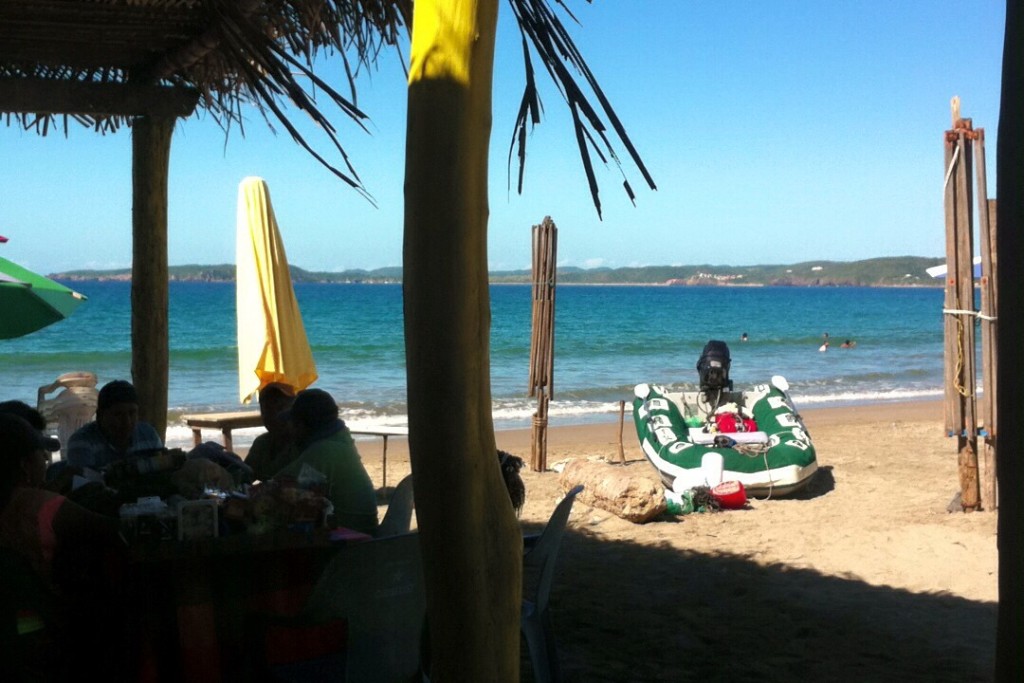
Our dinghy being guarded by an entourage of beach salespeople sitting at a local restaurant in La Manzanilla
Once on the beach in La Manzanilla, I bought a necklace from a local street vendor in exchange for her friends watching over our dinghy while we were in town. That seemed to work well, as we came back to a secure dinghy. We managed to find the Carniceria (meat store), Pescaria (fish store) and Abarottes (grocery store), but before we bought anything but a few jugs of water, we wanted to find out if we could buy gas for the dinghy. Sure enough, two kilometers out of town, there was a store where you could buy gas in 5 gallon jugs, unadvertized. We agreed that Rick would take the fuel tank in a cab to fill it up while I did the rest of the shopping. All went as planned. The Pescaria had only one type of local fish for sale and was literally waiting for the next fishing boat to arrive, to see what else they might have to sell. Rick had his heart set on shrimp, and I discovered from a kind woman shopping at the Pescaria that everybody buys shrimp frozen at the Abarottes. So she headed me in the right direction to buy from the best Abarottes in town, the “Sam’s Club” of La Manzanilla, she called it. It was a corner store only about 200 feet square but she was right, it was the best stocked Abarottes in town.
Once we bought the ice, our time left in town was limited, so Rick ran out and picked up a six pack for the trip back and we were on our way. We made it out through the surf just fine, but being still a little rusty with this starting the motor under pressure thing, we forgot to put the key in the motor and couldn’t figure out why it wouldnt start! While Rick located the key, I kept rowing so we wouldn’t be swept back into the surf. Another successful launch.
The trip back across the bay was fun, now that we knew we had enough fuel to get back, although the wind and waves had picked up during the interim. We toured around the anchorage and beach a bit, getting to know the area.
After a little rest on the boat, we deshelled and deveined the shrimp we bought, and then took another dinghy ride, this time to explore fishing/snorkling holes and drop off our garbage at the nearby campground. What a lovely campground! It is situated at the estuary, right where the river and the bay meet.
Rick made me his special camarones al diablo for dinner that night.
I thought to myself, we are going to enjoy Tenacatita.
A few days later …
We explored the estuary yesterday in our dinghy. It started out like a fairly wide river but then got narrower and narrower until there were mangrove vines forming a low hung canopy over our heads, and no place wide enough to turn around. Just at that point, we were surprised by a tourist panga coming up from our rear, wanting to pass us. Moving over deeper into the mangrove roots (filled with unimaginable biting things I was sure) to let them by was not my most favorite part of the trip, but knowing that a panga could make it further upstream reassured me that we could too. The canal that lead all the way to the town of Tenacatita was blocked off, although the blockage was not far from the town, we guessed. (The blockage was due to some land disputes a few years ago). We did have the option of a right fork at that point, which took us through some land apparently cleared for farming, although nothing had been planted. The open sky gave us a clearer view of the many egrets that called the area home. We never did spot a crocodile, but it was probably just because our eyes aren’t trained to distinguish them from logs. Especially in the heavily overgrown mangroves, they were there. A neighboring, returning boat told us they had seen their favorite croc in his same spot again this year. On the way back from the estuary tour, we stopped off at La Palapa, the only restaurant on the anchorage side of the beach, and grabbed a beer and some conversation, meeting for the first time, the Mayor of Tenacatita.
A classic “only in Mexico” story happened a few days later. One of the cruisers who had been to Tenacatita when you could still take your dinghy up the estuary to the town, was trying to find out what was necessary to return the estuary to its previous state. He wanted to be able to take his dinghy all the way up to the town again. But it was blocked off and severely overgrown after several years of neglect. Within just a matter of days, he found the panga driver who had the concession from the government to still take people up the estuary. It was in this concessioner’s best interest to see that path cleared. So the concessioner got his panga, a bunch of tools including several chain saws, and a bunch of his friends, to join all the cruisers in their dinghies who were willing to come out and fight the mangrove swamp. In two days they had nearly all of the route cleared. This, mind you, had been disputed territory only a few years back, with lawsuits and police protection and private security everywhere. To think that in a matter of just a few years, a group could take it upon themselves to restore that estuary route is beyond comprehension in any governmental situation except the likes of Mexico.
Friday night was the Mayor’s Raft Up. The Mayor of Tenacatita is an aging hippie who grew up in a commune; his wife supported their kids’ college by perfecting the art of tie-dye. They live on their boat in Tenacatita during the season and apparently have done so for a long time, and at some point some years back, were crowned mayor and first lady of Tenacatita. He announced on the radio net that all boaters were invited to bring food to share and their favorite beverage, and meet with their dinghies in a certain area of the anchorage to swap stories and talents. Yes, everyone was asked to share a talent. A mother sang a sailing song she wrote to the tune of “My favorite things,” encouraging her daughters to recite poems they had memorized; an excellent guitar player and singer from Bend, Oregon sang a song about a pony and a boat; one woman passed her hand-made beaded jewelry around; and others told stories or played the harmonica or the didgeridoo. Dishes were passed around clockwise amongst the two dozen or so dinghies that were there, everyone taking a little scoop of each, and somehow all the plates got back to their owners. As darkness fell and the party was breaking up, we were invited by our neighboring dinghy to join them on their powerboat with the Bend, Oregon folks and another boat we knew from our first season here, who also happened to be from Bend. The powerboat was a luxurious, expensive boat with a living area that seated 8 comfortably, a coffee table that raised and lowered electronically, and a widescreen tv behind a cabinet the length of the room. We got back late after breaking out our best tequila but a good time was had by all.
The next day, we got a lift with the powerboat folks back to the little town of La Manzanilla and spent a fun day exploring the crocodile refuge (lots of very large crocs – did you know they eat their young, so only one out of a hundred survive, and they can live to be 80 to 100 years old?) A couple of mandatory crossings on rickety suspension bridges over the refuge made us a little nervous, as well as seeing the croc in isolation because he slipped away from the refuge and down to the beach and ate a dog one too many times! The powerboat folks were delightful; she is a dancer and we are hoping to hook up with them n La Paz to take them salsa dancing.
Well as I write this, I am just relaxing and enjoying a few moments to myself while Rick is out fishing in the dinghy. Hopefully he will come home with dinner! If not, we still have the other half of his excellent camerones al diablo to enjoy. The sun is about to set, at which time I expect to hear one or two cruisers sending out a loud conch moan to announce cocktail time. It is a rough life.

